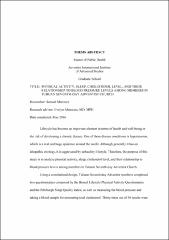Physical activity, sleep, cholesterol level and their relationship to blood pressure levels among members in the Tubuan Seventh-day Adventist church
Abstract
Lifestyle has become an important element in terms of health and well-being or
the risk of developing a chronic disease. One of these disease conditions is hypertension,
which is a real and huge epidemic around the world. Although generally it has an
idiopathic etiology, it is aggravated by unhealthy lifestyle. Therefore, the purpose of this
study is to analyze physical activity, sleep, cholesterol level, and their relationship to
blood pressure levels among members in Tubuan Seventh-day Adventist Church.
Using a correlational design, Tubuan Seventh-day Adventist members completed
two questionnaires composed by the Brunel Lifestyle Physical Activity Questionnaire
and the Pittsburgh Sleep Quality Index, as well as measuring the blood pressure and
taking a blood sample for measuring total cholesterol. Thirty-three out of 36 results were
analyzed. The participants were between 30 and 60 years old with a higher number of
women (57.6%).
Men were practicing more intense physical activity than women. Ages 41-50
years were performing more physical activity compared to all groups. Single and married
participants were practicing similar levels of physical activity. In terms of sleep, most of
the participants had good sleep quality (66.7%) and over half (54.5%) of the participants
were sleeping 7 hours or more. Women had good sleep quality and longer hours of sleep
than men. Ages 30-50 years had good sleep quality and the category of 30-40 years had
the longest hours of sleep per night than the others. Single and married groups were
categorized as good sleepers and the single group had longer hours of sleep per night.
Regarding total cholesterol, two thirds (66.7%) of the participants was in the category of
desirable cholesterol. Men had a larger number of individuals in the category of desirable
total cholesterol than women. Ages 30-40 years had the majority of its participants in the
desirable category. The single group showed a slightly higher number of people in the
desirable level than the married group. In relation to blood pressure, slightly half (51.5%)
of the participants were prehypertensives. Women had a higher number of participants
with normal blood pressure than men. The majority of those ages 30-40 had normal blood
pressure in contrast to those at ages 41 and above that most were in the prehypertension
group. Significant difference in blood pressure was found only between ages 30-40 years
and 41-50 that had significantly better sleep quality than the 51 years and above group.
The predictive model of blood pressure included only the variable of total sleep quality
score. More research studies with a larger number of participants are recommended as
well as longitudinal and experimental studies. Finally, it would be very crucial to include
other health determinants in future research studies.


